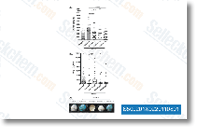Key culture of mouse microglia Glial cultures had been ready from your total brain tis sues of one day old C57BL 6 J mice and maintained for 8 14 days in Dulbeccos modified Eagles medium containing 10% fetal bovine serum, 1% penicillin streptomycin. All medium was changed each three days, from 24 h soon after the start off of culture. The microglia was obtained as floating cells above the mixed glial culture, and seeded onto six well plate using the density of 1. 0 105 cells cm2. Just after incu bation at 37 C inside a 5% CO2 environment overnight, we eliminated the medium and additional 400 ul TRIzol into each and every very well for RT PCR experiment. RT PCR The expression amounts of LPA receptors had been evaluated by RT PCR, in accordance to described technique. Cultured microglia and isolated L4 6 SC from naive mice I-BET151 concentration have been lysed with TRIzol for RNA planning. Total RNA was applied for cDNA synthesis with PrimeScript RT reagent Kit.
The cycling conditions for all primers had been 3 min at 95 C, then 50 cycles of 30 s at 95 C, thirty s at 55 C and kinase inhibitor SAR302503 two min at 72 C. The PCR primer sequences had been as follows. Then, the PCR solutions had been analyzed by 1. 5% agarose gel electrophoresis. Thermal paw withdrawal check On this test, nociception was measured since the latency to paw withdrawal evoked by exposure to a thermal stimu lus. Unanesthetized animals had been positioned in Plexiglas cages on major of the glass sheet and allowed an adaptation time period of one h. A thermal stimulator was positioned under the glass sheet and the target of your projection bulb was aimed precisely in the middle from the plantar surface of your animal. A mirror connected on the stimulator allow ted visualization of your plantar surface. A reduce off time of twenty s was set to avoid tissue damage. Phospholipase A2 action assays The routines of cPLA2 and iPLA2 have been detected working with the next assays as described previously.
Briefly, ipsilateral side of spinal dorsal horn was re moved. Soon after sonication and centrifugation at 20000 g for 20 min at four C, the supernatant was collected and kept on ice. The protein concentration  from the super natant was established from the Lowry procedure, plus the assays had been carried out using a cPLA2 assay kit to assess the cPLA2 exercise or even a modified cPLA2 assay kit to assess the iPLA2 activity, as described previously. Within the cPLA2 assay, the tissue samples had been incubated with the two BEL, an iPLA2 inhibitor, as well as a substrate, arachidonoyl thio Computer, at 20 C for one h in the assay buffer. The reactions have been stopped by DTNB EGTA for five min, along with the absorbances have been deter mined at 405 nm implementing a normal plate reader. To detect the activity of iPLA2, but not cPLA2, the samples were in cubated using the substrate, arachidonoyl thio Pc, at 20 C for one h in the modified Ca2 totally free buffer. The reactions were stopped from the addition of five,five dithiobis for 5 min. The action of PLA2 was defined as the percentage from the handle exercise as follows, injured tissues typical tissues 100.
from the super natant was established from the Lowry procedure, plus the assays had been carried out using a cPLA2 assay kit to assess the cPLA2 exercise or even a modified cPLA2 assay kit to assess the iPLA2 activity, as described previously. Within the cPLA2 assay, the tissue samples had been incubated with the two BEL, an iPLA2 inhibitor, as well as a substrate, arachidonoyl thio Computer, at 20 C for one h in the assay buffer. The reactions have been stopped by DTNB EGTA for five min, along with the absorbances have been deter mined at 405 nm implementing a normal plate reader. To detect the activity of iPLA2, but not cPLA2, the samples were in cubated using the substrate, arachidonoyl thio Pc, at 20 C for one h in the modified Ca2 totally free buffer. The reactions were stopped from the addition of five,five dithiobis for 5 min. The action of PLA2 was defined as the percentage from the handle exercise as follows, injured tissues typical tissues 100.
Transcriptase Signal
Telomerases are part of a distinct subgroup of RNA-dependent polymerases.
